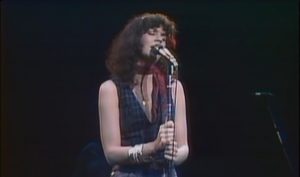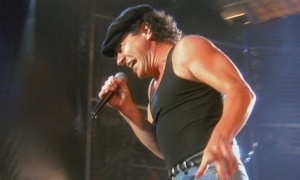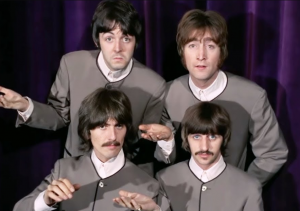5 Classic Songs Made Iconic Only By These Rock Legends

via Van Halen / YouTube
After decades and decades of music, certain songs transcend their original renditions to become timeless classics. What makes them truly iconic is often the magic spun by legendary artists who take a familiar melody and infuse it with their brilliance.
In this exploration of musical alchemy, we talk about five classic songs that have become synonymous with the rock legends who breathed new life into them.
From the unmistakable shake-it-up energy of The Beatles’ rendition of “Twist and Shout” to the sultry rock ‘n’ roll swagger of The Rolling Stones’ take on “Ain’t Too Proud to Beg”, each track tells a story not just of its origin but of the transformative touch of rock royalty.
Get ready to rediscover the familiar, as we explore the extraordinary and enduring impact of rock legends on five classic songs that stand as a testament to the power of artistic reinterpretation.
1. “Twist and Shout” by The Beatles (Originally by The Isley Brothers)
The infectious energy of “Twist and Shout” by The Beatles serves as a beacon of rock ‘n’ roll dynamism, originally penned by The Isley Brothers. This rendition catapulted the song to iconic status with The Beatles’ unmistakable charisma and exuberance.
Though The Beatles’ rendition bears the unmistakable influence of the Isleys’ original version, the transformative touch of rock brilliance brought by John Lennon’s raw vocals and the band’s harmonious synergy turned this rhythm and blues classic into a rock anthem that reverberates through generations.
During the recording of the now iconic cover, the Fab Four were on the verge of finishing an extensive recording session, during which they managed to swiftly record the entirety of their debut U.K. album, Please Please Me. Lennon’s vocal cords were nearly exhausted from the extensive singing that night, particularly when they tackled “Twist and Shout”.
Despite the strain on Lennon’s voice, it was precisely the rawness of the performance that contributed to its enduring memorability.
2. “Ain’t Too Proud to Beg” by The Rolling Stones (Originally by The Temptations)
The Rolling Stones, known for their sultry rock ‘n’ roll swagger, introduced a new dimension to this timeless anthem originally popularized by The Temptations. Join us as we explore the magnetic allure of Mick Jagger’s vocals and the band’s signature instrumentation that transformed “Ain’t Too Proud to Beg”.
Mick Jagger’s distinct vocal delivery and the band’s expertly crafted instrumental arrangements played a pivotal role in defining this version as the band seamlessly infused their unique style into the soulful origins of “Ain’t Too Proud to Beg”.
Despite being avid enthusiasts of soul and R&B music, as evidenced by their original compositions like “I Got the Blues”, The Stones weren’t particularly renowned for covering songs during their peak success in the late ’70s and early ’80s—especially not with their singles.
It’s conceivable that Mick Jagger and Keith Richards may have experienced a degree of songwriting fatigue by the time of their 1974 album It’s Only Rock ‘n Roll. This potential fatigue could explain why “Ain’t Too Proud to Beg” emerged as a single; they pulled it off, adding another iconic song to their extensive discography.
3. “Oh, Pretty Woman” by Van Halen (Originally by Roy Orbison)
The distinctive elegance of this Roy Orbison classic is reinvented with Van Halen’s signature rock prowess, marking a unique intersection of styles.
The instrumental choices and vocal interpretation employed by Eddie’s iconic crew define this version, showcasing the band’s ability to reinterpret a classic with their own rocking flair. David Lee Roth’s electrifying energy and EVH’s guitars injected new life into this timeless ballad.
The band initially grappled with the challenge of being measured against Orbison’s acrobatic vocals. Nevertheless, Van Halen managed to impart a remarkable twist to the song, remaining true to the melody while infusing it with an additional rhythmic punch.
The experience is elevated when the song is heard in the broader context of the complete Diver Down album, seamlessly and triumphantly emerging from the atmospheric (and downright underrated) instrumental “Intruder”.
4. “Susie Q” by Creedence Clearwater Revival (Originally by Dale Hawkins)
Clearwater Revival, this classic track by Dale Hawkins underwent a metamorphosis, as they infused it with their distinctive swampy, bluesy rock sound.
The trademark bluesy rock sound characteristic of CCR played a crucial role in reshaping the song, contributing to its distinct flavor. This stomping energy gave life to the rockabilly classic, setting their rendition apart from the original.
And this isn’t the only time CCR covered the classics, as it took lead vocalist and songwriter John Fogerty some time to cultivate his songwriting prowess; “Susie Q”, originally recorded by Hawkins in 1957 with the exceptional guitar work of James Burton, was one of the best ones they covered.
Stu Cook and Doug Clifford on rhythm powered the song with a gritty foundation, and Fogerty delivered vocals with a fervor akin to possession. The band introduced an extended instrumental jam to the composition, although it was later edited out for the abbreviated version released as a hit single in 1968.
5. “Something in the Air” by Tom Petty and the Heartbreakers (Originally by Thunderclap Newman)
“Something in the Air” by the short-lived Thunderclap Newman took on a new life thanks to the stylistic rendition by Tom Petty and the Heartbreakers
The instrumentation and vocal interpretation delivered by Petty define this rendition, showcasing the band’s ability to reinterpret a classic while adding their signature touch. The intriguing story behind the Thunderclap Newman also helped the song cultivate its own legend.
Thunderclap Newman was a one-hit wonder of a band formed by The Who guitarist Pete Townshend and The Who manager Kit Lamber in order to give a platform for Andy “Thunderclap” Newman.
Regardless of their brevity, “Something in the Air” successfully blended psychedelic and baroque rock on the musical front, embodying Flower Power positivity in its lyrics. In 1993, Tom Petty and the Heartbreakers undertook an exceptionally faithful cover, with Keen’s high-pitched vocals ideally suited for Petty’s interpretation.
















